Corporate Social Responsibility Report: Westpac Bank's CSR Strategies
VerifiedAdded on 2020/05/28
|10
|2017
|40
Report
AI Summary
This report provides a comprehensive analysis of Corporate Social Responsibility (CSR), focusing on its implementation within Westpac Bank. It begins by defining CSR and highlighting its significance for business success, followed by an overview of Westpac's operations and its role in the Australian banking sector. The report then delves into the theoretical practices of incorporating sustainability, examining the Four Capital Model—human, financial, environmental, and manufacturing capital—and its relevance to CSR activities. Furthermore, it explores the interests of various stakeholders, including society and shareholders, and discusses the potential conflicts and synergies between them. The report concludes by emphasizing the importance of CSR for long-term business viability and suggests strategies for Westpac to enhance its CSR initiatives, such as promoting environmental awareness and addressing stakeholder interests effectively. The report utilizes credible sources to support its arguments and provides a well-structured analysis of CSR principles and practices.
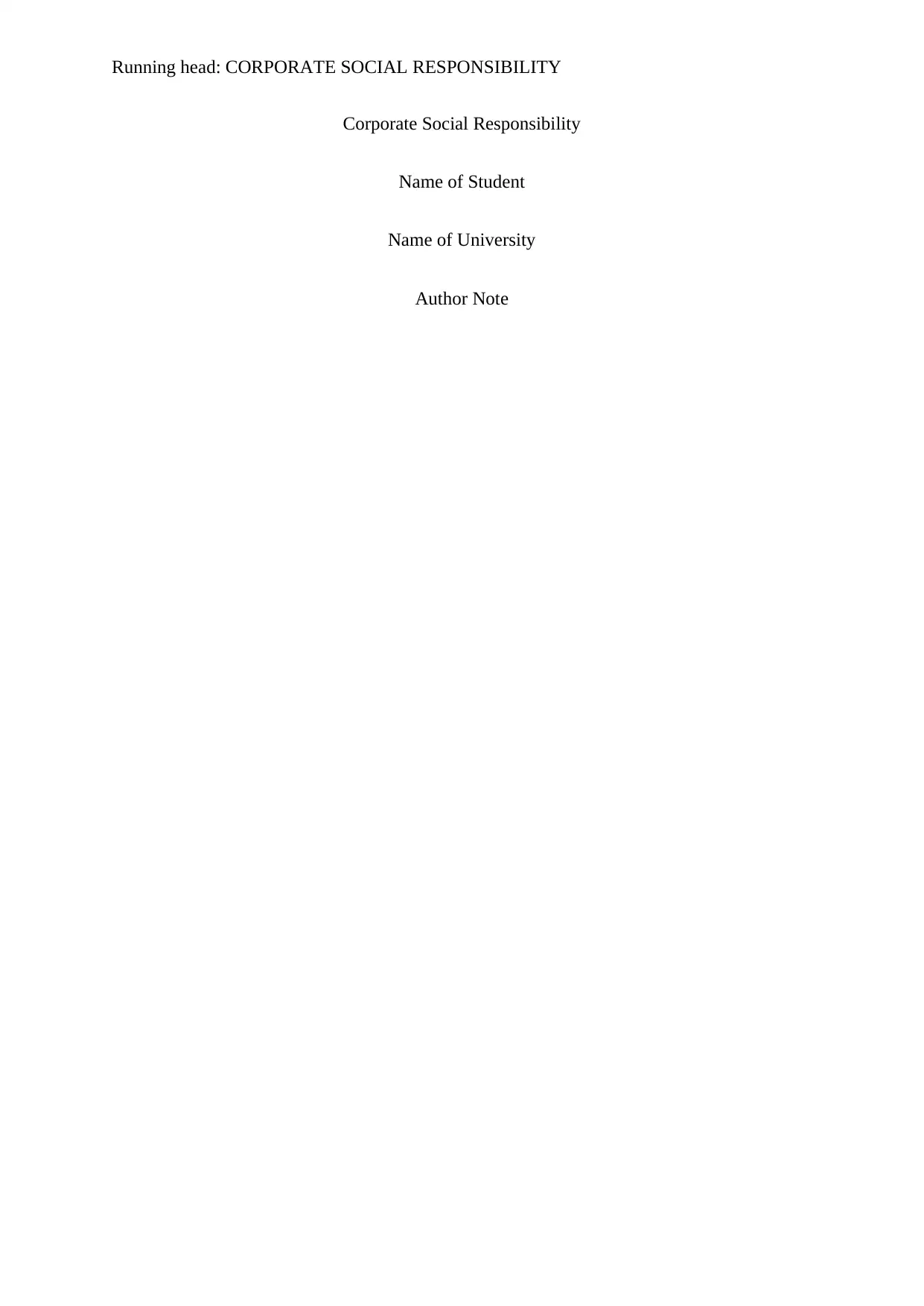
Running head: CORPORATE SOCIAL RESPONSIBILITY
Corporate Social Responsibility
Name of Student
Name of University
Author Note
Corporate Social Responsibility
Name of Student
Name of University
Author Note
Paraphrase This Document
Need a fresh take? Get an instant paraphrase of this document with our AI Paraphraser
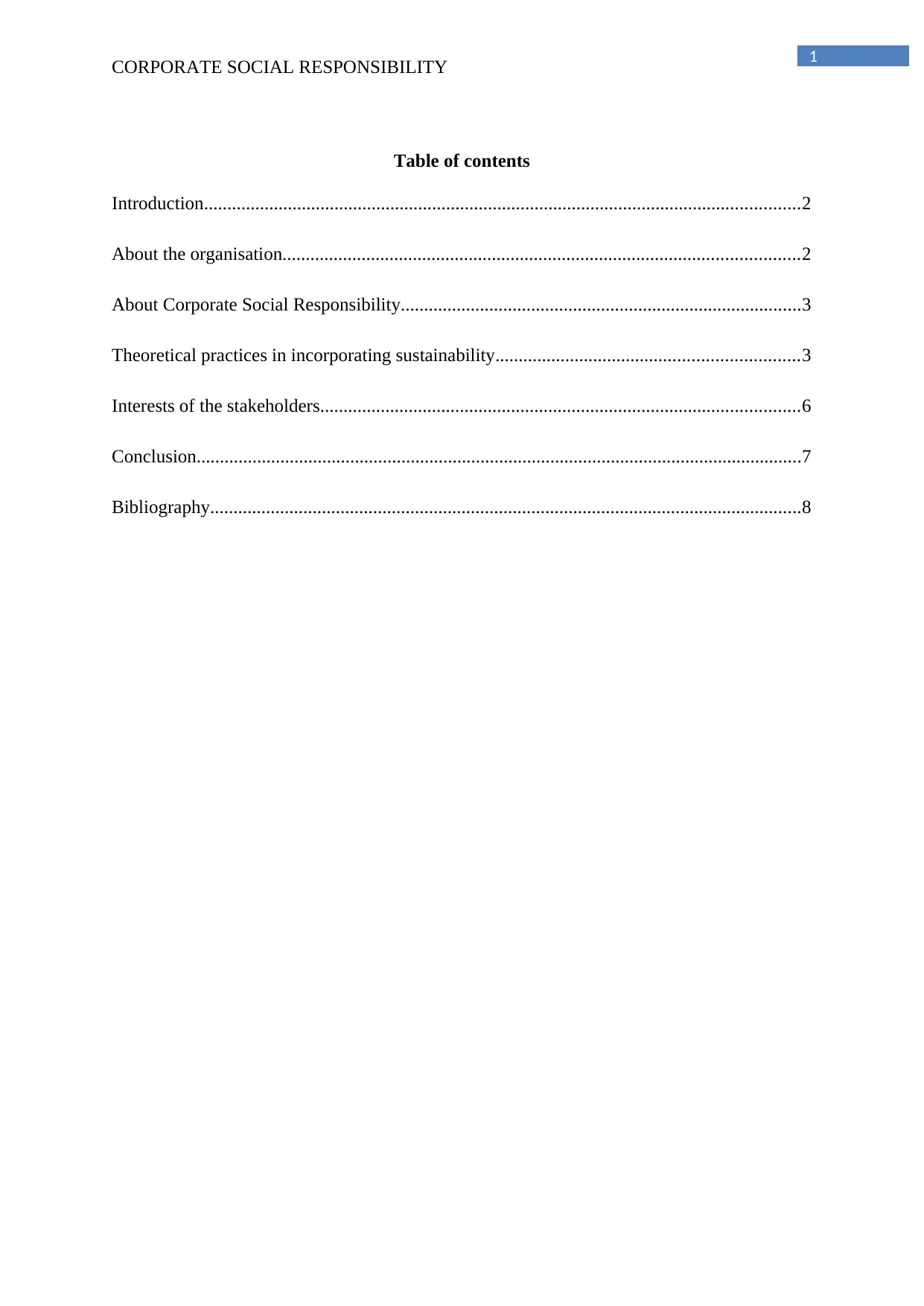
1
CORPORATE SOCIAL RESPONSIBILITY
Table of contents
Introduction................................................................................................................................2
About the organisation...............................................................................................................2
About Corporate Social Responsibility......................................................................................3
Theoretical practices in incorporating sustainability.................................................................3
Interests of the stakeholders.......................................................................................................6
Conclusion..................................................................................................................................7
Bibliography...............................................................................................................................8
CORPORATE SOCIAL RESPONSIBILITY
Table of contents
Introduction................................................................................................................................2
About the organisation...............................................................................................................2
About Corporate Social Responsibility......................................................................................3
Theoretical practices in incorporating sustainability.................................................................3
Interests of the stakeholders.......................................................................................................6
Conclusion..................................................................................................................................7
Bibliography...............................................................................................................................8
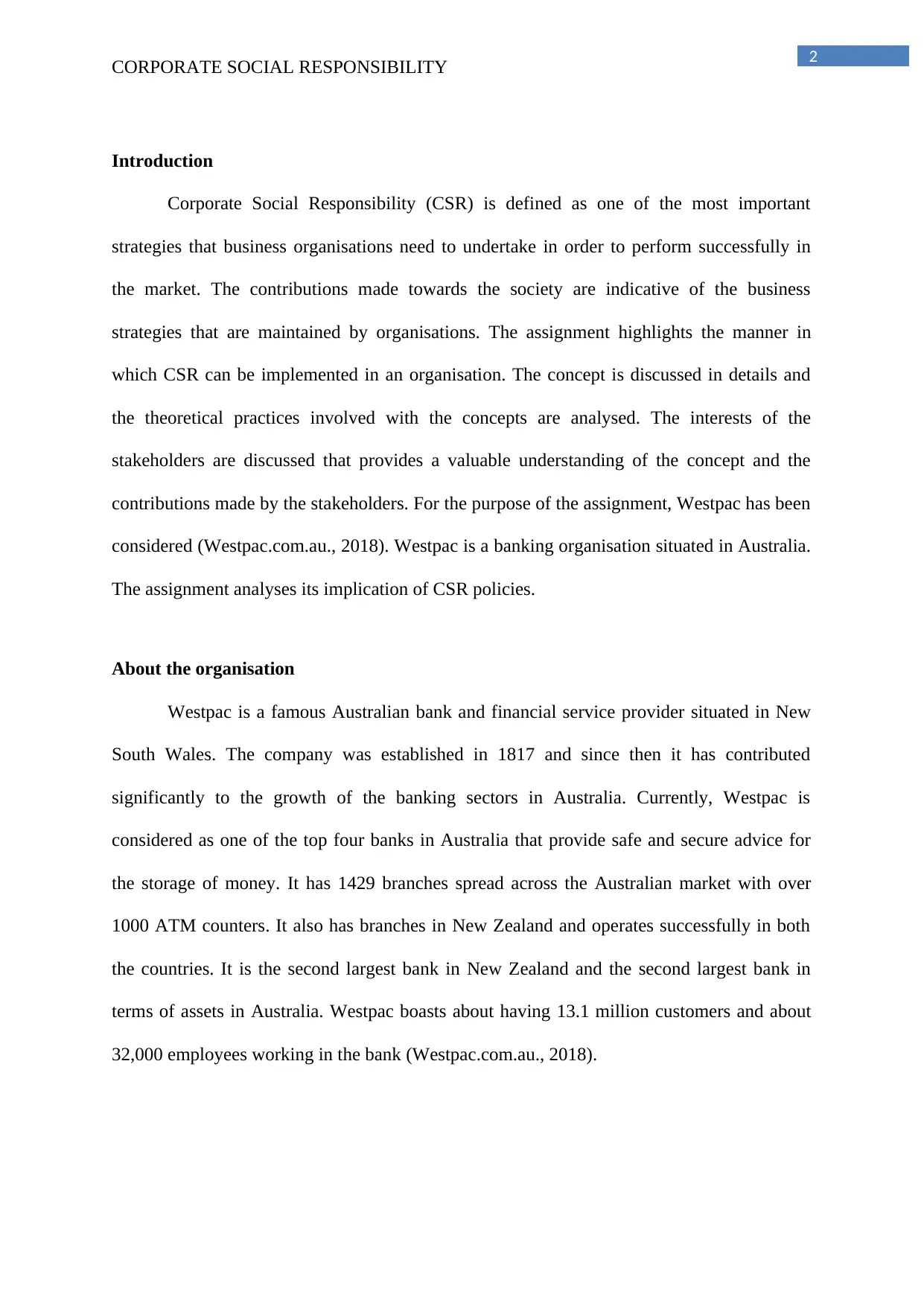
2
CORPORATE SOCIAL RESPONSIBILITY
Introduction
Corporate Social Responsibility (CSR) is defined as one of the most important
strategies that business organisations need to undertake in order to perform successfully in
the market. The contributions made towards the society are indicative of the business
strategies that are maintained by organisations. The assignment highlights the manner in
which CSR can be implemented in an organisation. The concept is discussed in details and
the theoretical practices involved with the concepts are analysed. The interests of the
stakeholders are discussed that provides a valuable understanding of the concept and the
contributions made by the stakeholders. For the purpose of the assignment, Westpac has been
considered (Westpac.com.au., 2018). Westpac is a banking organisation situated in Australia.
The assignment analyses its implication of CSR policies.
About the organisation
Westpac is a famous Australian bank and financial service provider situated in New
South Wales. The company was established in 1817 and since then it has contributed
significantly to the growth of the banking sectors in Australia. Currently, Westpac is
considered as one of the top four banks in Australia that provide safe and secure advice for
the storage of money. It has 1429 branches spread across the Australian market with over
1000 ATM counters. It also has branches in New Zealand and operates successfully in both
the countries. It is the second largest bank in New Zealand and the second largest bank in
terms of assets in Australia. Westpac boasts about having 13.1 million customers and about
32,000 employees working in the bank (Westpac.com.au., 2018).
CORPORATE SOCIAL RESPONSIBILITY
Introduction
Corporate Social Responsibility (CSR) is defined as one of the most important
strategies that business organisations need to undertake in order to perform successfully in
the market. The contributions made towards the society are indicative of the business
strategies that are maintained by organisations. The assignment highlights the manner in
which CSR can be implemented in an organisation. The concept is discussed in details and
the theoretical practices involved with the concepts are analysed. The interests of the
stakeholders are discussed that provides a valuable understanding of the concept and the
contributions made by the stakeholders. For the purpose of the assignment, Westpac has been
considered (Westpac.com.au., 2018). Westpac is a banking organisation situated in Australia.
The assignment analyses its implication of CSR policies.
About the organisation
Westpac is a famous Australian bank and financial service provider situated in New
South Wales. The company was established in 1817 and since then it has contributed
significantly to the growth of the banking sectors in Australia. Currently, Westpac is
considered as one of the top four banks in Australia that provide safe and secure advice for
the storage of money. It has 1429 branches spread across the Australian market with over
1000 ATM counters. It also has branches in New Zealand and operates successfully in both
the countries. It is the second largest bank in New Zealand and the second largest bank in
terms of assets in Australia. Westpac boasts about having 13.1 million customers and about
32,000 employees working in the bank (Westpac.com.au., 2018).
⊘ This is a preview!⊘
Do you want full access?
Subscribe today to unlock all pages.

Trusted by 1+ million students worldwide
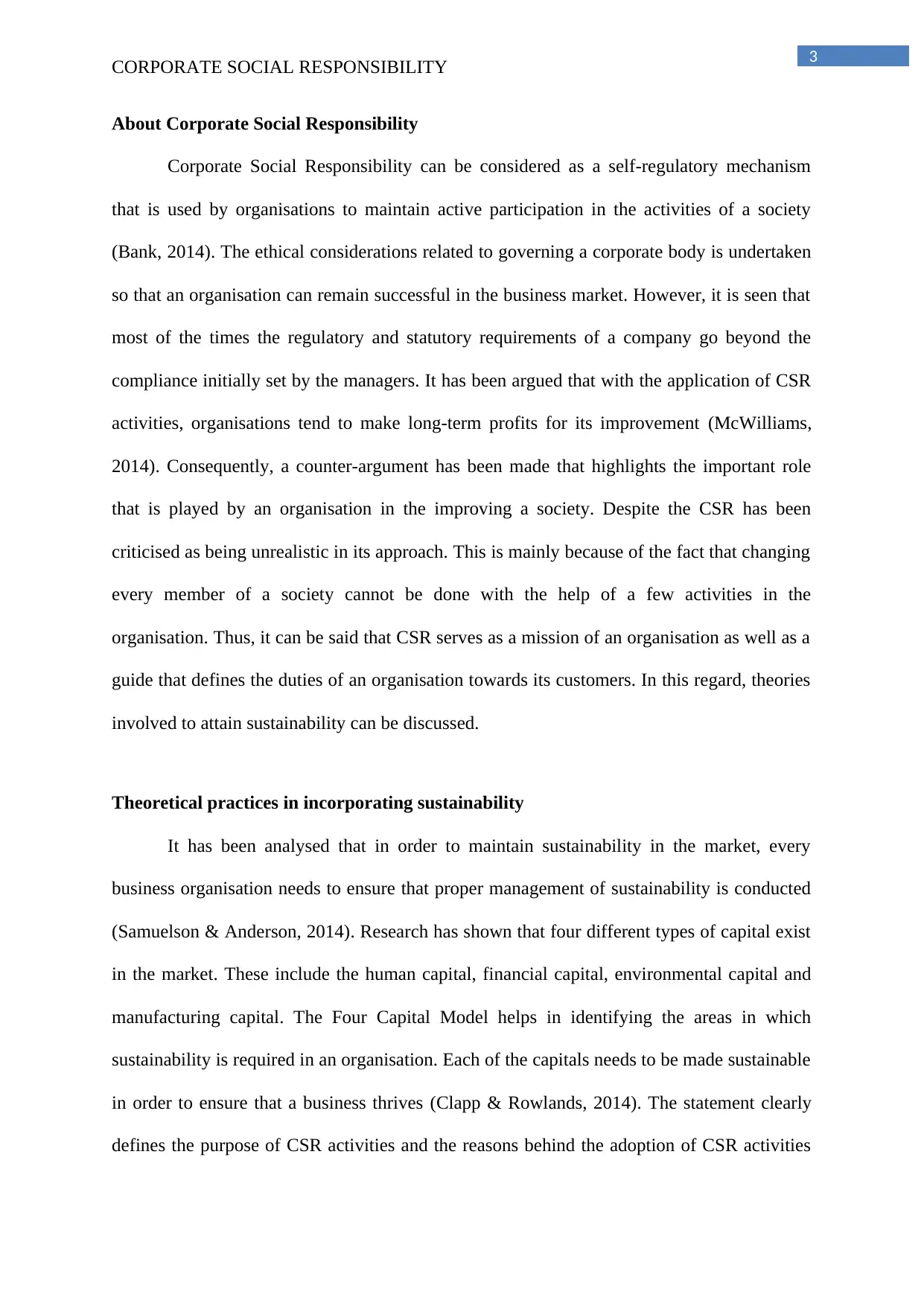
3
CORPORATE SOCIAL RESPONSIBILITY
About Corporate Social Responsibility
Corporate Social Responsibility can be considered as a self-regulatory mechanism
that is used by organisations to maintain active participation in the activities of a society
(Bank, 2014). The ethical considerations related to governing a corporate body is undertaken
so that an organisation can remain successful in the business market. However, it is seen that
most of the times the regulatory and statutory requirements of a company go beyond the
compliance initially set by the managers. It has been argued that with the application of CSR
activities, organisations tend to make long-term profits for its improvement (McWilliams,
2014). Consequently, a counter-argument has been made that highlights the important role
that is played by an organisation in the improving a society. Despite the CSR has been
criticised as being unrealistic in its approach. This is mainly because of the fact that changing
every member of a society cannot be done with the help of a few activities in the
organisation. Thus, it can be said that CSR serves as a mission of an organisation as well as a
guide that defines the duties of an organisation towards its customers. In this regard, theories
involved to attain sustainability can be discussed.
Theoretical practices in incorporating sustainability
It has been analysed that in order to maintain sustainability in the market, every
business organisation needs to ensure that proper management of sustainability is conducted
(Samuelson & Anderson, 2014). Research has shown that four different types of capital exist
in the market. These include the human capital, financial capital, environmental capital and
manufacturing capital. The Four Capital Model helps in identifying the areas in which
sustainability is required in an organisation. Each of the capitals needs to be made sustainable
in order to ensure that a business thrives (Clapp & Rowlands, 2014). The statement clearly
defines the purpose of CSR activities and the reasons behind the adoption of CSR activities
CORPORATE SOCIAL RESPONSIBILITY
About Corporate Social Responsibility
Corporate Social Responsibility can be considered as a self-regulatory mechanism
that is used by organisations to maintain active participation in the activities of a society
(Bank, 2014). The ethical considerations related to governing a corporate body is undertaken
so that an organisation can remain successful in the business market. However, it is seen that
most of the times the regulatory and statutory requirements of a company go beyond the
compliance initially set by the managers. It has been argued that with the application of CSR
activities, organisations tend to make long-term profits for its improvement (McWilliams,
2014). Consequently, a counter-argument has been made that highlights the important role
that is played by an organisation in the improving a society. Despite the CSR has been
criticised as being unrealistic in its approach. This is mainly because of the fact that changing
every member of a society cannot be done with the help of a few activities in the
organisation. Thus, it can be said that CSR serves as a mission of an organisation as well as a
guide that defines the duties of an organisation towards its customers. In this regard, theories
involved to attain sustainability can be discussed.
Theoretical practices in incorporating sustainability
It has been analysed that in order to maintain sustainability in the market, every
business organisation needs to ensure that proper management of sustainability is conducted
(Samuelson & Anderson, 2014). Research has shown that four different types of capital exist
in the market. These include the human capital, financial capital, environmental capital and
manufacturing capital. The Four Capital Model helps in identifying the areas in which
sustainability is required in an organisation. Each of the capitals needs to be made sustainable
in order to ensure that a business thrives (Clapp & Rowlands, 2014). The statement clearly
defines the purpose of CSR activities and the reasons behind the adoption of CSR activities
Paraphrase This Document
Need a fresh take? Get an instant paraphrase of this document with our AI Paraphraser
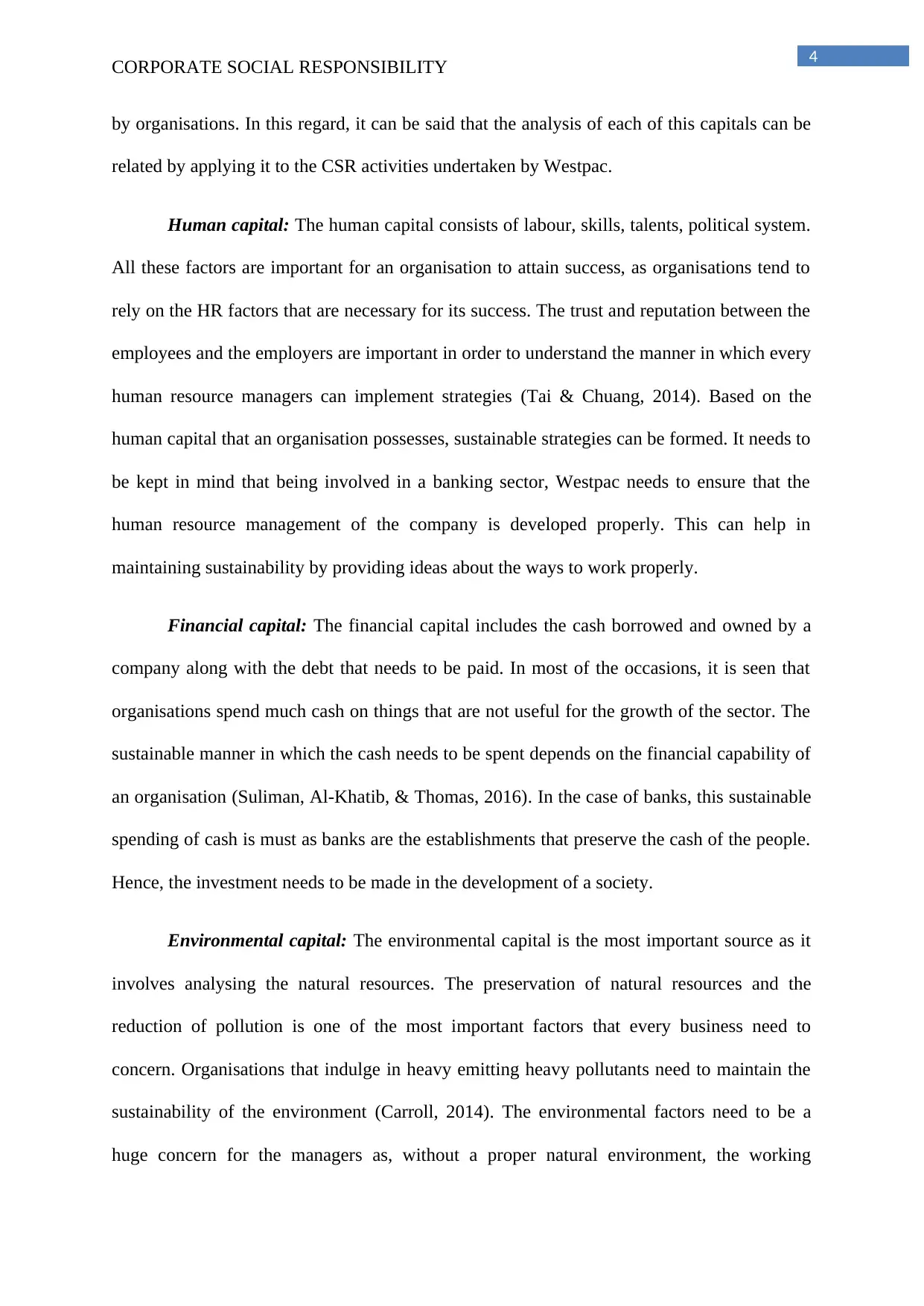
4
CORPORATE SOCIAL RESPONSIBILITY
by organisations. In this regard, it can be said that the analysis of each of this capitals can be
related by applying it to the CSR activities undertaken by Westpac.
Human capital: The human capital consists of labour, skills, talents, political system.
All these factors are important for an organisation to attain success, as organisations tend to
rely on the HR factors that are necessary for its success. The trust and reputation between the
employees and the employers are important in order to understand the manner in which every
human resource managers can implement strategies (Tai & Chuang, 2014). Based on the
human capital that an organisation possesses, sustainable strategies can be formed. It needs to
be kept in mind that being involved in a banking sector, Westpac needs to ensure that the
human resource management of the company is developed properly. This can help in
maintaining sustainability by providing ideas about the ways to work properly.
Financial capital: The financial capital includes the cash borrowed and owned by a
company along with the debt that needs to be paid. In most of the occasions, it is seen that
organisations spend much cash on things that are not useful for the growth of the sector. The
sustainable manner in which the cash needs to be spent depends on the financial capability of
an organisation (Suliman, Al-Khatib, & Thomas, 2016). In the case of banks, this sustainable
spending of cash is must as banks are the establishments that preserve the cash of the people.
Hence, the investment needs to be made in the development of a society.
Environmental capital: The environmental capital is the most important source as it
involves analysing the natural resources. The preservation of natural resources and the
reduction of pollution is one of the most important factors that every business need to
concern. Organisations that indulge in heavy emitting heavy pollutants need to maintain the
sustainability of the environment (Carroll, 2014). The environmental factors need to be a
huge concern for the managers as, without a proper natural environment, the working
CORPORATE SOCIAL RESPONSIBILITY
by organisations. In this regard, it can be said that the analysis of each of this capitals can be
related by applying it to the CSR activities undertaken by Westpac.
Human capital: The human capital consists of labour, skills, talents, political system.
All these factors are important for an organisation to attain success, as organisations tend to
rely on the HR factors that are necessary for its success. The trust and reputation between the
employees and the employers are important in order to understand the manner in which every
human resource managers can implement strategies (Tai & Chuang, 2014). Based on the
human capital that an organisation possesses, sustainable strategies can be formed. It needs to
be kept in mind that being involved in a banking sector, Westpac needs to ensure that the
human resource management of the company is developed properly. This can help in
maintaining sustainability by providing ideas about the ways to work properly.
Financial capital: The financial capital includes the cash borrowed and owned by a
company along with the debt that needs to be paid. In most of the occasions, it is seen that
organisations spend much cash on things that are not useful for the growth of the sector. The
sustainable manner in which the cash needs to be spent depends on the financial capability of
an organisation (Suliman, Al-Khatib, & Thomas, 2016). In the case of banks, this sustainable
spending of cash is must as banks are the establishments that preserve the cash of the people.
Hence, the investment needs to be made in the development of a society.
Environmental capital: The environmental capital is the most important source as it
involves analysing the natural resources. The preservation of natural resources and the
reduction of pollution is one of the most important factors that every business need to
concern. Organisations that indulge in heavy emitting heavy pollutants need to maintain the
sustainability of the environment (Carroll, 2014). The environmental factors need to be a
huge concern for the managers as, without a proper natural environment, the working
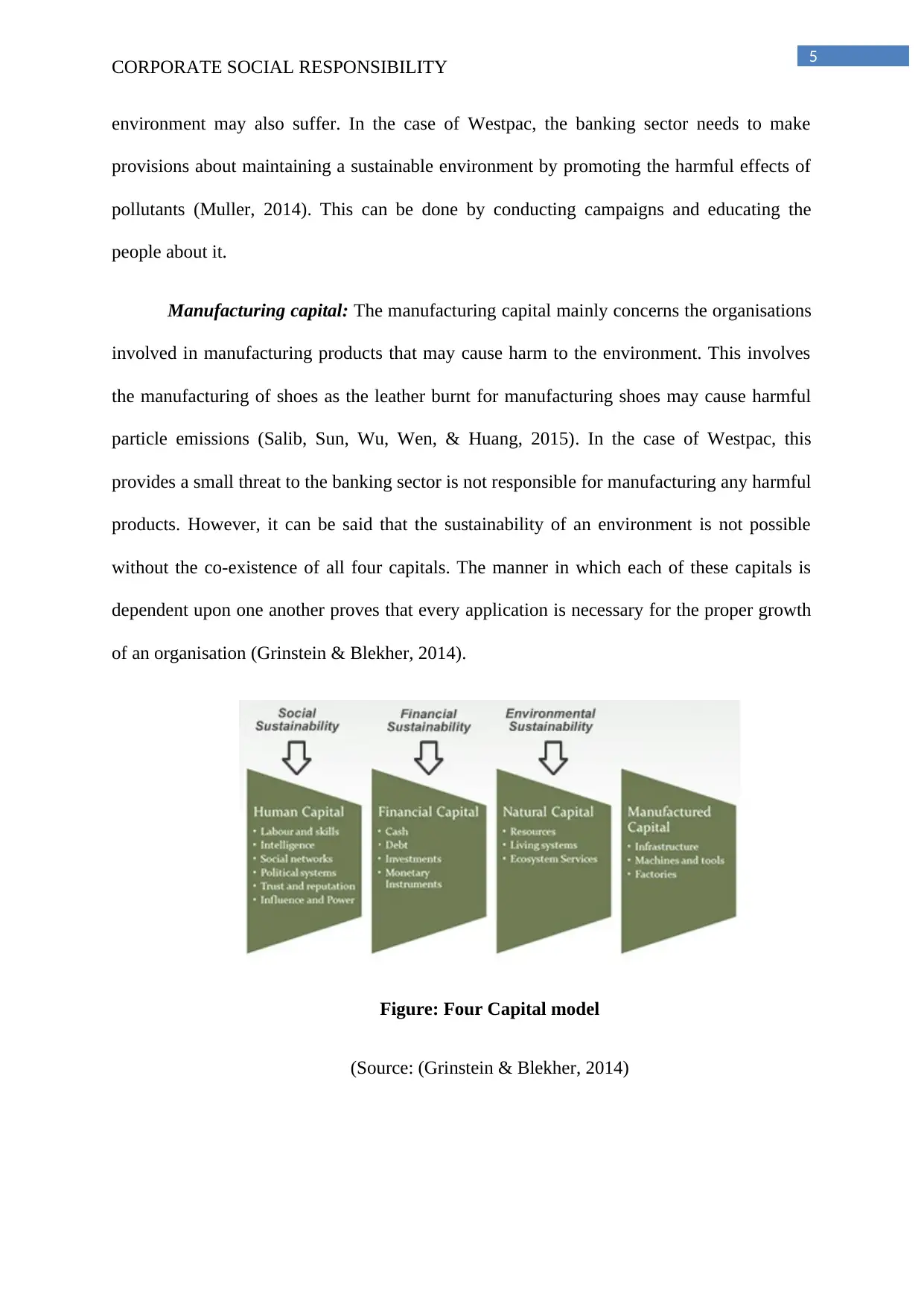
5
CORPORATE SOCIAL RESPONSIBILITY
environment may also suffer. In the case of Westpac, the banking sector needs to make
provisions about maintaining a sustainable environment by promoting the harmful effects of
pollutants (Muller, 2014). This can be done by conducting campaigns and educating the
people about it.
Manufacturing capital: The manufacturing capital mainly concerns the organisations
involved in manufacturing products that may cause harm to the environment. This involves
the manufacturing of shoes as the leather burnt for manufacturing shoes may cause harmful
particle emissions (Salib, Sun, Wu, Wen, & Huang, 2015). In the case of Westpac, this
provides a small threat to the banking sector is not responsible for manufacturing any harmful
products. However, it can be said that the sustainability of an environment is not possible
without the co-existence of all four capitals. The manner in which each of these capitals is
dependent upon one another proves that every application is necessary for the proper growth
of an organisation (Grinstein & Blekher, 2014).
Figure: Four Capital model
(Source: (Grinstein & Blekher, 2014)
CORPORATE SOCIAL RESPONSIBILITY
environment may also suffer. In the case of Westpac, the banking sector needs to make
provisions about maintaining a sustainable environment by promoting the harmful effects of
pollutants (Muller, 2014). This can be done by conducting campaigns and educating the
people about it.
Manufacturing capital: The manufacturing capital mainly concerns the organisations
involved in manufacturing products that may cause harm to the environment. This involves
the manufacturing of shoes as the leather burnt for manufacturing shoes may cause harmful
particle emissions (Salib, Sun, Wu, Wen, & Huang, 2015). In the case of Westpac, this
provides a small threat to the banking sector is not responsible for manufacturing any harmful
products. However, it can be said that the sustainability of an environment is not possible
without the co-existence of all four capitals. The manner in which each of these capitals is
dependent upon one another proves that every application is necessary for the proper growth
of an organisation (Grinstein & Blekher, 2014).
Figure: Four Capital model
(Source: (Grinstein & Blekher, 2014)
⊘ This is a preview!⊘
Do you want full access?
Subscribe today to unlock all pages.

Trusted by 1+ million students worldwide

6
CORPORATE SOCIAL RESPONSIBILITY
Interests of the stakeholders
After analysing the CSR activities and the model used for describing the effectiveness
of CSR, it can be said that the interests of the stakeholders are also important for the growth
and development of an organisation. The interests of the stakeholders are important, as
without the contribution of the stakeholders it may be difficult for an organisation to continue
its business in the market (Carroll, 2014). In this regard, it can be said that the stakeholders of
Westpac can be the society in which it is based. This is because CSR activities take into
account the interests of the society and the people involved in it. The growth and
development of the society are one of the biggest CSR activities that every organisation need
to undertake (Suliman, Al-Khatib, & Thomas, 2016). Thus, it can be said that the society in
which Westpac is situated can take a keen interest in its development. Hence, setting up a
campaign for the eradication of pollution or education in the society can be successful for
Westpac.
However, the shareholders of the company may have different interests (Tai &
Chuang, 2014). The shareholders of Westpac would want the development of the
organisation. Thus, it can be said that the campaign that is to be launched in the society can
easily benefit the bank. Campaigns such as more investment or more loans can be launched in
the society so that the people residing in it can invest for the betterment of the company.
Thus, the conflicting interests between the two main stakeholders may prove to be a negative
factor for Westpac. In order to mitigate this, Westpac needs to make certain that a
stakeholders meeting is held so that the common interest of the stakeholders can be taken into
considerations (Grinstein & Blekher, 2014). This can benefit the organisation, as priorities
can be considered and accordingly adjustments can be made. In this regard, a conclusion can
be drawn that highlights the important aspect of CSR in Westpac.
CORPORATE SOCIAL RESPONSIBILITY
Interests of the stakeholders
After analysing the CSR activities and the model used for describing the effectiveness
of CSR, it can be said that the interests of the stakeholders are also important for the growth
and development of an organisation. The interests of the stakeholders are important, as
without the contribution of the stakeholders it may be difficult for an organisation to continue
its business in the market (Carroll, 2014). In this regard, it can be said that the stakeholders of
Westpac can be the society in which it is based. This is because CSR activities take into
account the interests of the society and the people involved in it. The growth and
development of the society are one of the biggest CSR activities that every organisation need
to undertake (Suliman, Al-Khatib, & Thomas, 2016). Thus, it can be said that the society in
which Westpac is situated can take a keen interest in its development. Hence, setting up a
campaign for the eradication of pollution or education in the society can be successful for
Westpac.
However, the shareholders of the company may have different interests (Tai &
Chuang, 2014). The shareholders of Westpac would want the development of the
organisation. Thus, it can be said that the campaign that is to be launched in the society can
easily benefit the bank. Campaigns such as more investment or more loans can be launched in
the society so that the people residing in it can invest for the betterment of the company.
Thus, the conflicting interests between the two main stakeholders may prove to be a negative
factor for Westpac. In order to mitigate this, Westpac needs to make certain that a
stakeholders meeting is held so that the common interest of the stakeholders can be taken into
considerations (Grinstein & Blekher, 2014). This can benefit the organisation, as priorities
can be considered and accordingly adjustments can be made. In this regard, a conclusion can
be drawn that highlights the important aspect of CSR in Westpac.
Paraphrase This Document
Need a fresh take? Get an instant paraphrase of this document with our AI Paraphraser

7
CORPORATE SOCIAL RESPONSIBILITY
Conclusion
Thus, it can be concluded that CSR is important in order to ensure that a business can
be conducted in a successful manner. Without the proper implementation of the CSR
activities, an organisation cannot maintain its longevity in the business. The manner in which
the CSR activities are conducted highlights the strategic implementation of the business
minds. In the case of Westpac, the sustainability of the environment needs to be enforced by
the spreading awareness. The company does not indulge in manufacturing products but can
help in creating awareness among the people about the negative and harmful effects of
pollution. Moreover, the interest of the stakeholders is also important as the company remains
in conflict with improving the society and the organisations.
CORPORATE SOCIAL RESPONSIBILITY
Conclusion
Thus, it can be concluded that CSR is important in order to ensure that a business can
be conducted in a successful manner. Without the proper implementation of the CSR
activities, an organisation cannot maintain its longevity in the business. The manner in which
the CSR activities are conducted highlights the strategic implementation of the business
minds. In the case of Westpac, the sustainability of the environment needs to be enforced by
the spreading awareness. The company does not indulge in manufacturing products but can
help in creating awareness among the people about the negative and harmful effects of
pollution. Moreover, the interest of the stakeholders is also important as the company remains
in conflict with improving the society and the organisations.
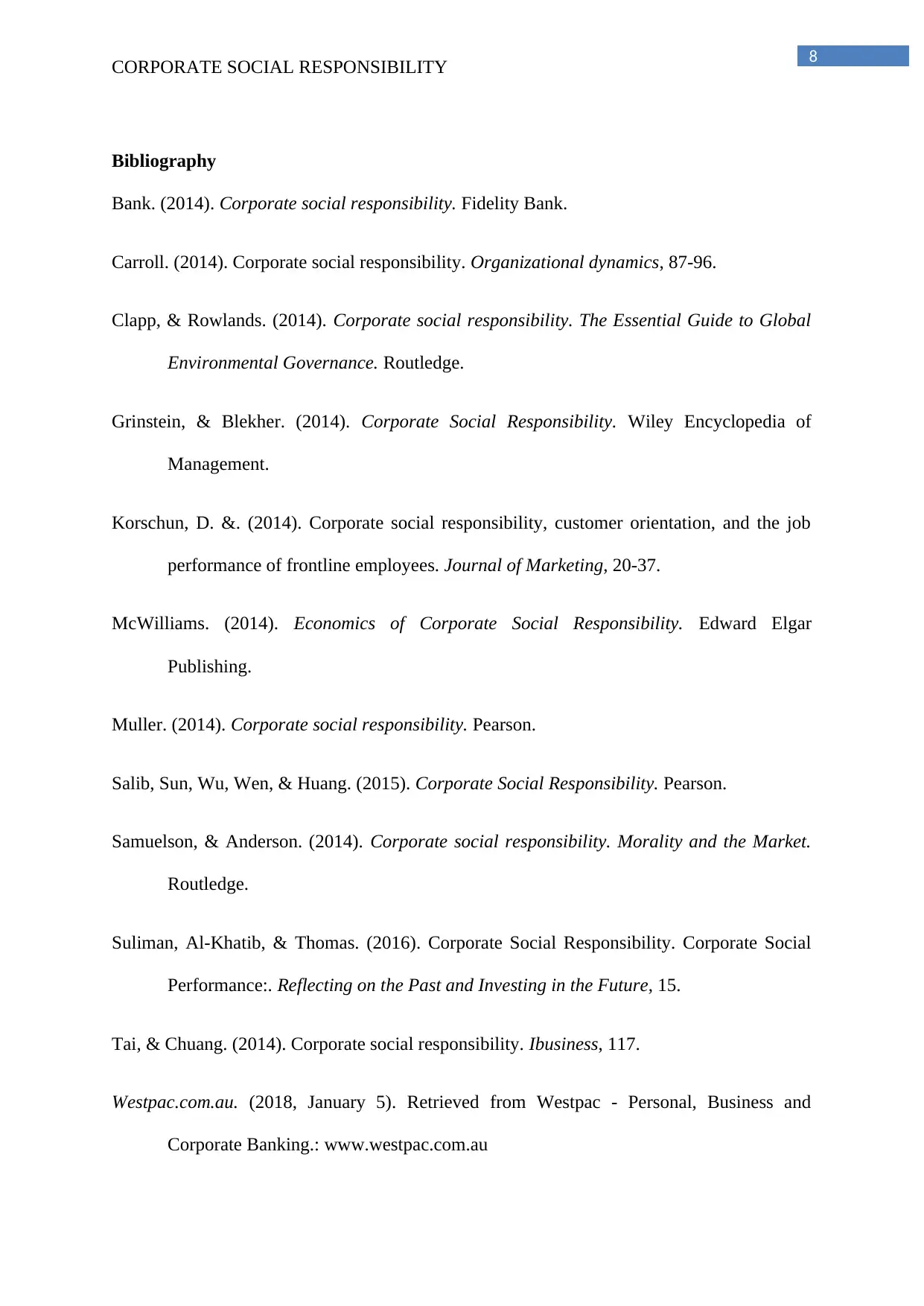
8
CORPORATE SOCIAL RESPONSIBILITY
Bibliography
Bank. (2014). Corporate social responsibility. Fidelity Bank.
Carroll. (2014). Corporate social responsibility. Organizational dynamics, 87-96.
Clapp, & Rowlands. (2014). Corporate social responsibility. The Essential Guide to Global
Environmental Governance. Routledge.
Grinstein, & Blekher. (2014). Corporate Social Responsibility. Wiley Encyclopedia of
Management.
Korschun, D. &. (2014). Corporate social responsibility, customer orientation, and the job
performance of frontline employees. Journal of Marketing, 20-37.
McWilliams. (2014). Economics of Corporate Social Responsibility. Edward Elgar
Publishing.
Muller. (2014). Corporate social responsibility. Pearson.
Salib, Sun, Wu, Wen, & Huang. (2015). Corporate Social Responsibility. Pearson.
Samuelson, & Anderson. (2014). Corporate social responsibility. Morality and the Market.
Routledge.
Suliman, Al-Khatib, & Thomas. (2016). Corporate Social Responsibility. Corporate Social
Performance:. Reflecting on the Past and Investing in the Future, 15.
Tai, & Chuang. (2014). Corporate social responsibility. Ibusiness, 117.
Westpac.com.au. (2018, January 5). Retrieved from Westpac - Personal, Business and
Corporate Banking.: www.westpac.com.au
CORPORATE SOCIAL RESPONSIBILITY
Bibliography
Bank. (2014). Corporate social responsibility. Fidelity Bank.
Carroll. (2014). Corporate social responsibility. Organizational dynamics, 87-96.
Clapp, & Rowlands. (2014). Corporate social responsibility. The Essential Guide to Global
Environmental Governance. Routledge.
Grinstein, & Blekher. (2014). Corporate Social Responsibility. Wiley Encyclopedia of
Management.
Korschun, D. &. (2014). Corporate social responsibility, customer orientation, and the job
performance of frontline employees. Journal of Marketing, 20-37.
McWilliams. (2014). Economics of Corporate Social Responsibility. Edward Elgar
Publishing.
Muller. (2014). Corporate social responsibility. Pearson.
Salib, Sun, Wu, Wen, & Huang. (2015). Corporate Social Responsibility. Pearson.
Samuelson, & Anderson. (2014). Corporate social responsibility. Morality and the Market.
Routledge.
Suliman, Al-Khatib, & Thomas. (2016). Corporate Social Responsibility. Corporate Social
Performance:. Reflecting on the Past and Investing in the Future, 15.
Tai, & Chuang. (2014). Corporate social responsibility. Ibusiness, 117.
Westpac.com.au. (2018, January 5). Retrieved from Westpac - Personal, Business and
Corporate Banking.: www.westpac.com.au
⊘ This is a preview!⊘
Do you want full access?
Subscribe today to unlock all pages.

Trusted by 1+ million students worldwide

9
CORPORATE SOCIAL RESPONSIBILITY
CORPORATE SOCIAL RESPONSIBILITY
1 out of 10
Related Documents
Your All-in-One AI-Powered Toolkit for Academic Success.
+13062052269
info@desklib.com
Available 24*7 on WhatsApp / Email
![[object Object]](/_next/static/media/star-bottom.7253800d.svg)
Unlock your academic potential
Copyright © 2020–2025 A2Z Services. All Rights Reserved. Developed and managed by ZUCOL.





